3.14 Flies – Large Animals
Learning Objectives
- Describe the lesions associated with horseflies, stableflies, blackflies, Culicoides gnats and horn flies.
- Learn the flies associated with cutaneous hypersensitivity in horses and the most common fly genus.
- Learn the flies associated with ventral midline dermatitis in horses and the most common fly genus.
- Know the fly that can cause systemic sign after biting horses.
- Learn the important measures involved in the control of fly problems.
-
General Considerations:
- Domestic livestock are susceptible to almost constant attack from a variety of flies.
- Economic losses associated with fly annoyance, damage to hide and disease transmission can be significant.
- Annual costs to producers for livestock insect control and losses resulting from theses ectoparasites around the world are very high.
- Flies not only can cause direct damage to animals but also serve as vectors of diseases.
-
Horseflies (deerflies)
- Cause: Tabanids (Diptera: Tabanidae)
- Tabanus spp.
- Cause: Tabanids (Diptera: Tabanidae)
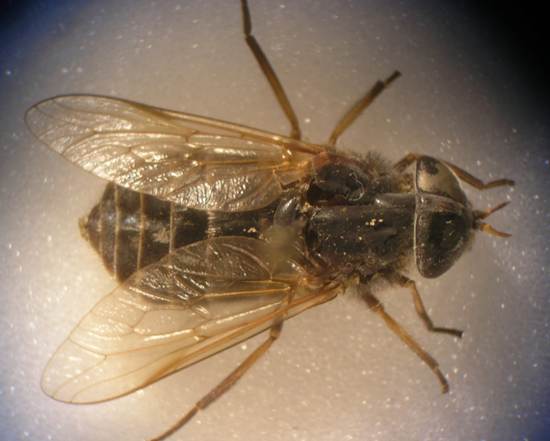
-
-
- Chrysops spp.
- Haematopota spp.
- Fly populations are largest in summer and most active during hot days.
- Clinical Signs:
- Adult tabanids are hematophagous flies and inflict painful bites, which can cause bleeding at the biting sites.
- Hypersensitive animals can develop pruritic or painful papules and wheals with a central ulcer and hemorrhagic crust.
- Favorite biting sites are the ventrum, legs, neck, and withers.
- Annoyance caused by these flies can result in failure to gain or maintain weight in horses.
- Diagnosis:
- History, clinical signs and presence of flies
- Treatment:
- Control of tabanids is very difficult.
- Stabling during the day.
- Heavy applications of synergized pyrethrins with repellents are recommended.
- Ear tags impregnated with permethrin and cypermethrin are reported to be effective.
-
-
Stable flies
- Cause:
- Stomoxys calcitrans (Diptera: Muscidae)
- Cause:
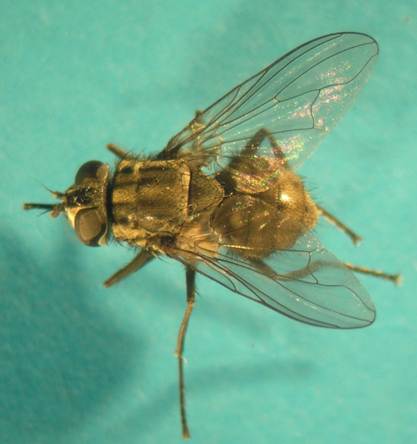
-
-
- It is a cosmopolitan cause of annoyance and disease transmission (viral, protozoal, and helminthic).
- Fly populations are larger in summer and fall.
- Clinical Signs:
- Stable flies cause great annoyance and irritation.
- Bleeding punctures and pruritic and painful papules develop at the biting sites.
- Hypersensitive animals can develop crusted wheals on the neck, back, chest, groin and legs.
- Diagnosis:
- History, clinical signs and presence of flies.
- Treatment:
- Destruction of breeding places.
- Use of residual environmental sprays and aerosols.
- Ear tags impregnated with cypermethrin.
- At least twice weekly removals of moist bedding, hay, and manure from the barn area.
-
-
Black Flies (buffalo gnats, sandflies)
- Cause:
- Simulium spp. (Diptera: Simuliidae)
- The family Simulidae contains several species of blood-sucking flies, which attack animals as well as man.
- They are particularly troublesome in regions with warm weather being most active during the morning and late afternoon.
- The flies are dark colored, vary in length from 1 to 5 mm, and have a characteristic appearance with the thorax humped over the head.
- Simulium spp. (Diptera: Simuliidae)
- Cause:
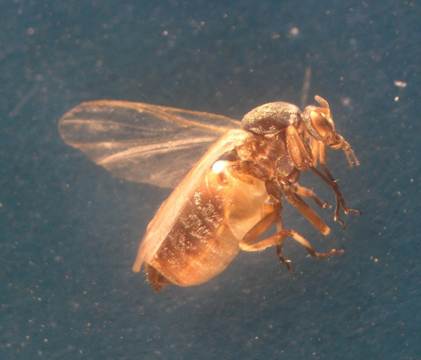
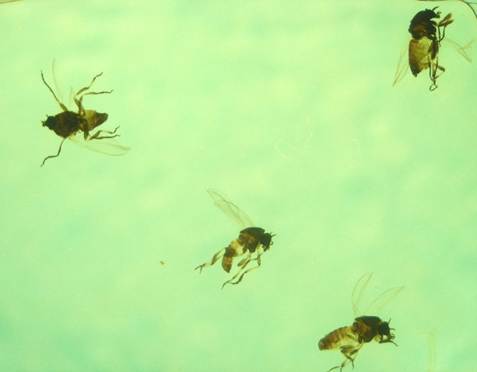
-
-
-
- They cause significant annoyance and irritation.
- Only females suck blood with dark colored animals being particularly selected for attack.
- In addition to the cutaneous damage resulting from the bites, the flies secrete a potent toxin that can cause cardiopulmonary problems and even death.
-
- Clinical Signs:
- Cutaneous Manifestations:
- Bites produce wounds, which are quickly covered with droplets of dried blood.
- Usual sites include the udder, scrotum, prepuce, inner surface of the thigh and upper forelimbs, thorax, ears, ventral abdomen, chest and natural body orifices.
- It is likely that each species of black fly has a favorite site. For example: Simulium vittatum and Simulium argus feed most exclusively on the ears (these flies can transmit the virus associated with the verrucous, depigmented plaques found on the inner surface of the pinnae of horses called aural plaques).
- Urticaria and angioedema may be a prominent sign when larger numbers of flies attack an animal.
- It is not known if a hypersensitivity reaction plays a role in the pathogenesis of the skin lesions.
- Systemic Manifestations:
- Systemic signs only occur when large numbers of flies attack an animal and are evident either immediately or within a few hours of attack.
- Affected animals are weak and listless with a rapid pulse and respiratory rate.
- The body temperature is normal or subnormal; increase occurs only in advanced or terminal cases.
- In severe cases, death may occur within a few hours to several days.
- Cutaneous Manifestations:
- Diagnosis:
- Aside from the droplets of dried blood on the inner pinnae surface, incriminating Simulium spp bites as the cause of an equine dermatosis is subjective at the best.
- Findings that favor such a diagnosis include:
- Multiple animals involved.
- Occurrence during the fly season.
- Skin lesions consisting of small bloody crusts.
- The most important finding is observing black flies feeding on affected animals.
- The attack of horses by large numbers of black flies resulting in systemic signs is usually not a diagnostic problem.
- Treatment:
- Control of simulids is difficult because the adults can fly 3 to 5 km or more.
- Stabling during the day preferably in screened stalls.
- Insect repellents should be applied especially to sites of predilection, at least two or three times a day.
- Treatment of skin lesions involves gentle cleaning of affected areas to remove the crusts and the use of systemic or topical steroids as indicated.
- Any secondary pyoderma should be treated appropriately.
-
-
Culicoides Gnats
- Cause:
- Culicoides spp.
- Cause:
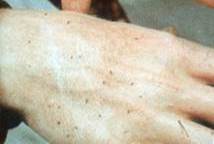

-
-
- The eggs are laid in water.
- Gnat populations are largest during warm weather and most active when there is little or no breeze.
- Adult gnats are blood-feeders and the different species vary in their preferred feeding time (morning or evening) and sites (dorsum or ventrum).
- Clinical Signs:
- The bites produce immediate pain and pruritus followed by papules and wheals.
- Lesions and symptoms may persist for several days.
- In the horse, Culicoides gnats are the main cause of insect hypersensitivity and ventral midline dermatitis.
-

-
- Treatment:
- Control of these gnats is difficult.
- Adult gnats are of such minute size (1 to 3 mm long) that they can pass through conventional 14-16- mesh mosquito screens.
- Combinations of stabling (dusk, dawn, or constantly), special screens (32-mesh), residual environmental sprays and time-operated spray-mist insecticide systems are usually employed.
- Treatment:
-
Horn Flies
- Cause: (Diptera-Muscidae)
- Haematobia (Lyperosia) spp.
- Horn flies are a ubiquitous cause of annoyance among cattle and horses.
- The eggs are laid in the fresh dung of cattle.
- Fly populations are largest in summer.
- Adult horn flies (3 to 4 mm long) are bloodsuckers.
- Clinical Signs:
- Bites produce pruritic to painful papules and wheals with a central crust.
- Flies tend to congregate around the base of the horns, shoulders, and back when the ambient temperature is less than 70°F and on the ventrum when it is hot or rainy or both.
- In horses, Haematobia irritans is a cause of ventral midline dermatitis in the U.S.
- Treatment:
- Control of horn flies is relatively easy because adult flies spend most of their life on the host.
- Regular spraying with various organophosphates or self-application of organophosphates with the use of back-rubbers or dust bags achieves good control.
- A report showed that a single application of doramectin pour-on, at a dosage of 0.5 mg/kg (1 ml/10kg) was very effective against Haematobia irritans in cattle. The efficacy was greater than 92.8% for at least 6 weeks after treatment. Ivermectin pour-on applied at the same dosage showed shorter persistent efficacy than doramectin.
- Cause: (Diptera-Muscidae)
Important Facts
- Flies can not only cause direct skin damage to animals but also serve as vectors of diseases.
- Horseflies are bloodsuckers and can cause painful, pruritic papules and wheals with ulcers and hemorrhagic crusts on the ventrum, legs, neck and withers.
- Stable flies can cause great annoyance and crusted wheals on the neck, back, chest, groin and legs.
- Blackflies are most active during the morning and late afternoon and the bites of the bloodsucker female produce wounds, which are covered with hemorrhagic crusts.
- Systemic signs and even death can occur if large numbers of blackflies attack an animal.
- Culicoides gnats can cause insect hypersensitivity and ventral midline dermatitis in the horse.
- Horn flies are a cause of equine ventral midline dermatitis in the U.S.
- Flies are particularly troublesome during summer and fall.
References
Farkas R, Grafner G, Hendrickx MO. BL Persistent efficacy of doramectin pour-on against Haematobia irritans in cattle. Vet Rec 2000; 146:378-380.
Scott DW. Large Animal Dermatology. 1st edn. Philadelphia: W.B. Saunders, 1988; 239-245.

